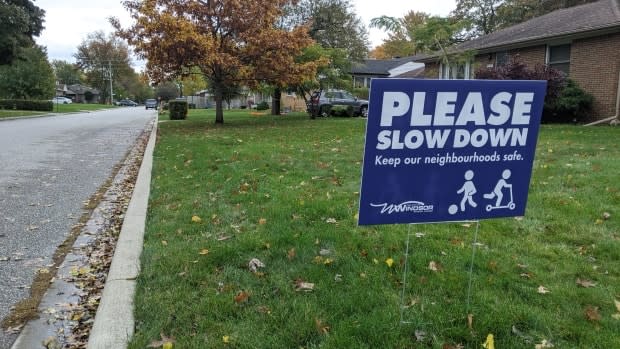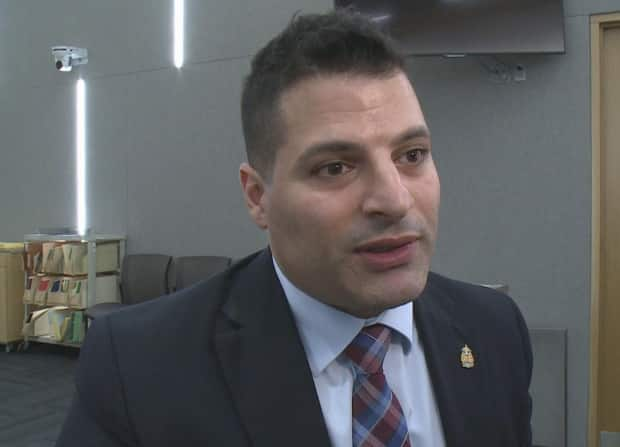Windsor considers lowering speed limit to 40km/h for many city streets
Windsor councillors have voted to reduce the city's speed limit to 40 km/h — a recommendation that will now head to council for final approval.
The environment, transportation and public safety committee decided at its meeting Wednesday afternoon to decrease the city-wide speed limit to 40 km/h and only place 50 km/h speed limit signs on major roads.
All councillors on the committee voted in favour of the recommendation except for Ward 1 Coun. Fred Francis, who said he wasn't convinced the lower limit would change the way people drive.
"I think as a stand alone solution it doesn't work by itself and actually the writer of the report does say that on page five of the report: just reducing the speed limit by itself without any other considerations or measures probably won't have that desired effect of slowing people down," he said.
Ontario's Highway Traffic Act sets default speed limits for urban areas at 50 km/h, but a 2017 amendment allows municipalities to establish their own speed limits if they choose.
In a March council meeting, Ward 8 Coun. Gary Kaschak asked city staff to look into the cost and timelines of doing just that.
Resident would rather speed bumps
A conversation on reducing speed limits in the city is something that Stacey Guthrie, who lives on Avondale Avenue in south Windsor supports. She says speeding is the biggest issue on her residential street.

Guthrie says some cars are going too fast.
"If I had to guess I would say that by the time they hit my house, [and] I'm six houses from the corner, is at least 70 [km/h]," she said.
But Guthrie doesn't think lowering speed limits in residential neighbourhoods is enough on its own.
"I've been trying for years to get the city to actually put in speed bumps," she said.
But another resident told CBC News they welcome the speed reduction in some neighbourhoods.
"I wouldn't have any issue with that at all, I think that'd be a great thing because as I say some people take these corners pretty quick," said Steve Laforet, adding that he doesn't support the reduced speed city-wide.
Committee agrees on Option 2
In the report considered by the standing committee Wednesday, city staff laid out three options council could pursue in order to reduce speed limits.
Option 1 involves keeping the default city speed limit at 50 km/h, lowering speed limits to 40 km/h on residential streets while installing signs on those streets to indicate the lower limit.
Option 2 involves reducing the default speed limit city-wide to 40 km/h, while select major roads will remain at 50 km/h and have signs indicating that.
Option 3 involves keeping the default city speed limit at 50 km/h, and creating 40 km/h "speed areas" in residential neighbourhoods, with fewer signs than Option 1.
The cost of implementing each option varies. The report estimates that Option 1 and Option 3 would cost just over $1 million each, with yearly maintenance costs coming in at $69,000 and $60,000 respectively. Option 2 would be significantly cheaper, both in terms of initial cost at $734,000 and maintenance costs at $39,000 yearly.
The time required to implement each option differs as well, with Option 1 and Option 3 taking 6 months minimum, while Option 2 would take two years minimum.
Ultimately the committee chose Option 2.
The report notes that whatever option the city chooses, or none at all, lowering speed limits alone is unlikely to cure drivers' lead feet.
"In general, most research has found that reducing speed limits, in and of itself, does not cause significant changes in operating speeds," it reads.
It says the speed limit changes would need to be part of a broader strategy to bring driving speeds down. Options on that front include redesigning streets, such as installing speed bumps, and/or greater police enforcement.
"Reductions in operating speeds have a clearly demonstrated safety benefit, both in terms of reducing the likelihood of collisions as well as the severity of collisions that do occur," the report reads.
On Wednesday morning, Ward 1 Coun. Fred Francis told CBC he had not yet decided which option he planned to support but that he prefers targetted speed limit reductions.

"I prefer to use it as a surgical tool where there is a certain problem, as opposed to a blanket tool hoping to solve specific issues in specific neighbourhoods," he said.
He said that he's received mixed messages from residents in his ward on how effective reducing speed limits and installing speed bumps have been at reducing driver speeds.
"In my opinion, it comes down to police enforcement," he said. "That is the best and fastest way to get people to slow down."
Francis noted that increased speed limit enforcement would stretch police resources, something the report submitted to council warned of as well.

 Yahoo Finance
Yahoo Finance 